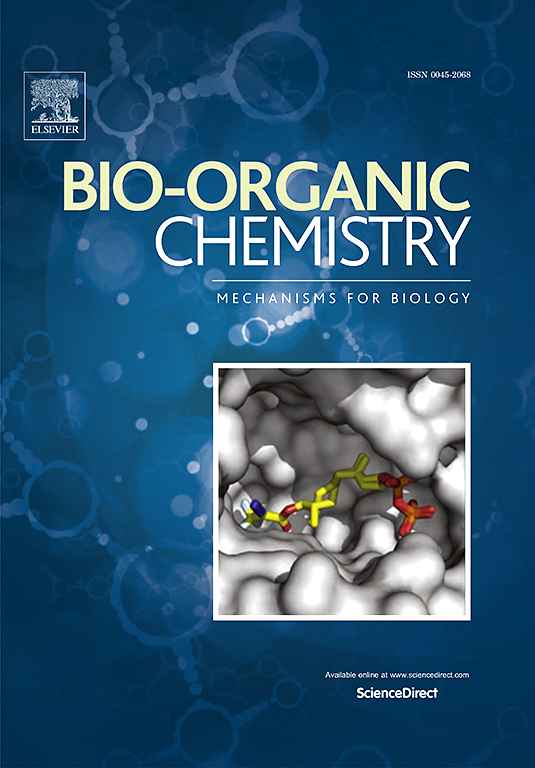Anti-Cancer Potential of Dehydrozingerone's Phenoxy-Acetamide Derivatives: Discovery of a Potent Lead with Dual Anti-Proliferative and Anti-Metastatic Activities
IF 4.5
2区 医学
Q1 BIOCHEMISTRY & MOLECULAR BIOLOGY
引用次数: 0
Abstract
Herein, we report the design and synthesis of twenty-eight novel phenoxy-acetamide derivatives of dehydrozingerone (DHZ), aimed at exploring their potential as anticancer agents. The newly synthesized compounds were characterized using NMR, mass spectrometry, and HPLC. The in vitro anticancer activity was evaluated against MCF-7, HCT-116, and A549 cancer cell lines, where compounds 2, 4, 9, 14, 26, and 27 exhibited the highest potency, with IC50 values ranging from 3.52 to 9.93 μM. These promising molecules were further tested against PC3 and Panc1 cell lines, demonstrating strong anticancer effects. Selectivity index analysis revealed that compound 14 demonstrated the highest selectivity for PC3, while compound 2 consistently exhibited notable selectivity across multiple cancer cell lines, highlighting their potential for targeted therapy. Clonogenic assays confirmed that compound 2 significantly reduced the long-term proliferative capacity of HCT-116 and MCF-7 cells in a dose-dependent manner. Mechanistic studies revealed that compound 2 induced cell cycle arrest by modulating Cyclin D1, leading to altered BAX/Bcl-2 and PARP levels, caspase cascade activation, and apoptotic cell death. Additionally, compound 2 regulated epithelial-mesenchymal transition (EMT), as evidenced by downregulation of Snail and upregulation of E-cadherin and occludin in a dose-dependent manner. Furthermore, molecular docking and ADMET predictions support compound 2 as a promising lead for anticancer drug discovery.

脱氢姜酮苯氧乙酰胺衍生物的抗癌潜力:发现具有双重抗增殖和抗转移活性的有效先导物
在此,我们设计和合成了28个新的脱氢姜酮(DHZ)苯氧基乙酰胺衍生物,旨在探索它们作为抗癌药物的潜力。采用核磁共振、质谱和高效液相色谱对新合成的化合物进行了表征。结果表明,化合物2、4、9、14、26和27对MCF-7、HCT-116和A549癌细胞的抑癌活性最高,IC50值在3.52 ~ 9.93 μM之间。这些有希望的分子进一步对PC3和Panc1细胞系进行了测试,显示出很强的抗癌作用。选择性指数分析显示,化合物14对PC3的选择性最高,而化合物2在多种癌细胞系中均表现出显著的选择性,这表明它们具有靶向治疗的潜力。克隆实验证实,化合物2显著降低HCT-116和MCF-7细胞的长期增殖能力,并呈剂量依赖性。机制研究表明,化合物2通过调节Cyclin D1诱导细胞周期阻滞,导致BAX/Bcl-2和PARP水平改变,caspase级联激活,凋亡细胞死亡。此外,化合物2调节上皮-间质转化(EMT),这可以通过蜗牛蛋白(Snail)的下调和E-cadherin和occludin的上调来证明,并呈剂量依赖性。此外,分子对接和ADMET预测支持化合物2作为抗癌药物发现的有希望的先导物。
本文章由计算机程序翻译,如有差异,请以英文原文为准。
求助全文
约1分钟内获得全文
求助全文
来源期刊

Bioorganic Chemistry
生物-生化与分子生物学
CiteScore
9.70
自引率
3.90%
发文量
679
审稿时长
31 days
期刊介绍:
Bioorganic Chemistry publishes research that addresses biological questions at the molecular level, using organic chemistry and principles of physical organic chemistry. The scope of the journal covers a range of topics at the organic chemistry-biology interface, including: enzyme catalysis, biotransformation and enzyme inhibition; nucleic acids chemistry; medicinal chemistry; natural product chemistry, natural product synthesis and natural product biosynthesis; antimicrobial agents; lipid and peptide chemistry; biophysical chemistry; biological probes; bio-orthogonal chemistry and biomimetic chemistry.
For manuscripts dealing with synthetic bioactive compounds, the Journal requires that the molecular target of the compounds described must be known, and must be demonstrated experimentally in the manuscript. For studies involving natural products, if the molecular target is unknown, some data beyond simple cell-based toxicity studies to provide insight into the mechanism of action is required. Studies supported by molecular docking are welcome, but must be supported by experimental data. The Journal does not consider manuscripts that are purely theoretical or computational in nature.
The Journal publishes regular articles, short communications and reviews. Reviews are normally invited by Editors or Editorial Board members. Authors of unsolicited reviews should first contact an Editor or Editorial Board member to determine whether the proposed article is within the scope of the Journal.
 求助内容:
求助内容: 应助结果提醒方式:
应助结果提醒方式:


